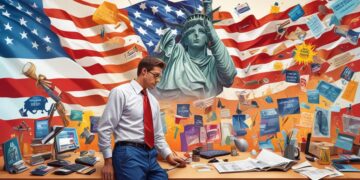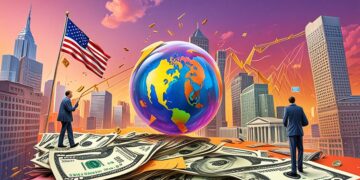The influence of American government policies on the economy

The Interplay of Policies and Economic Outcomes
The relationship between American government policies and the economy is profound and multifaceted. Each decision made at the policy level can ripple through various sectors, influencing everything from consumer behavior to employment rates. Understanding these dynamics is crucial for grasping how our nation thrives.
To grasp the impact of government policies on the economy, let’s delve deeper into some key examples.
Tax Policies
Tax policies play a pivotal role in shaping economic activity. For instance, when the government decides to lower income tax rates, individuals tend to have more disposable income. This increase often leads to enhanced consumer spending, which fuels demand for goods and services, subsequently boosting economic growth. An illustrative example can be seen in the Tax Cuts and Jobs Act of 2017, which aimed to stimulate the economy by lowering taxes for businesses and individuals. As a result, many companies reported increased investments and hiring, underscoring the direct correlation between tax structures and economic performance.
Trade Agreements
Another crucial area of interaction is trade agreements. Policies regarding imports and exports can significantly shape the landscape of local industries and job availability. Take, for example, the North American Free Trade Agreement (NAFTA), implemented in 1994. While it helped some sectors like agriculture and manufacturing grow, it also led to job losses in industries that couldn’t compete with lower-cost labor in Mexico. The results demonstrate how trade agreements can create both opportunities and challenges within the U.S. economy.
Regulatory Measures
Regulatory measures also exert substantial influence over economic growth. Regulations designed to protect the environment, ensure consumer safety, or maintain fair competition can either bolster economic vitality or stifle innovation. For instance, environmental regulations may impose costs on businesses, but they can also drive innovation in green technology, ultimately leading to sustainable economic growth. The debate over regulations often hinges on finding a balance that protects the public without hampering economic progress.
Throughout various historical contexts, government interventions often serve as a catalyst for economic growth or stagnation. During periods of recession, stimulus packages may be introduced to revive the economy; for example, the American Recovery and Reinvestment Act of 2009 aimed to stabilize the economy amid the financial crisis. Conversely, in times of economic surplus, governments may implement austerity measures to reduce debt levels, often sparking debate about the best path forward.
The effects of these policies reach beyond simple numerical data; they reverberate through communities, affecting real lives. Job creation or loss, changes in income levels, and even shifts in consumer behavior are all tied to the decisions made at the governmental level. This intertwining of policies and economic outcomes highlights the critical importance of informed governance. A clear understanding of these dynamics allows citizens to engage meaningfully in discussions around policies that will shape their economic futures.
As we delve deeper into the specifics of these influences, a clearer picture will emerge of how government decisions shape the economic landscape of the United States. Whether through tax reform, trade policy, or regulation, every decision carries with it the potential to foster growth or precipitate challenges. Thus, fostering a well-informed electorate is essential for sustaining and enhancing the economic health of the nation.
CHECK OUT: Click here to explore more
Key Aspects of Government Policies on Economic Performance
To fully appreciate the influence of American government policies on the economy, it is essential to explore several key areas where these policies intersect with economic performance. Among these areas, fiscal policy, monetary policy, and social welfare initiatives stand out as critical facets affecting the nation’s economic landscape. Each of these components plays a unique role in shaping economic outcomes, thus highlighting the necessity for a comprehensive understanding of their implications.
Fiscal Policy
Fiscal policy refers to the government’s approach to taxation and spending. By adjusting tax rates and government expenditures, policymakers can influence overall economic activity. For example, during periods of economic downturn, increased government spending can stimulate demand, providing a much-needed buffer for struggling businesses and workers. The implementation of the American Recovery and Reinvestment Act in 2009 showcased this approach, as it injected billions into the economy through infrastructure projects and tax cuts, ultimately helping to pull the nation out of recession.
Monetary Policy
Monetary policy, conducted by the Federal Reserve, governs the money supply and interest rates circulating within the economy. By manipulating these factors, the Fed can either encourage borrowing and investment or curb inflation. For instance, in response to the COVID-19 pandemic, the Fed slashed interest rates to near-zero levels, making credit more accessible to businesses and consumers alike. This strategy was aimed at stimulating spending and investment, essential for recovery. The ripple effects of such policies can be seen as increased consumer confidence often leads to a boost in retail sales, contributing to economic revival.
Social Welfare Policies
Social welfare policies, which include programs like Social Security, Medicare, and unemployment insurance, also play a critical role in economic stability. These initiatives not only provide safety nets for vulnerable populations but also stimulate economic activity by ensuring that individuals have the resources to spend on necessities. For instance, during economic downturns, programs that expand unemployment benefits help sustain consumer spending levels, keeping businesses afloat. The interconnectedness of social welfare programs and economic indicators underscores the importance of thoughtful policy-making.
Understanding the nuances of these policies reveals the broader implications for the economy. Here are some vital impacts of government policies on economic performance:
- Stimulating Growth: Effective fiscal and monetary policies can stimulate economic growth by fostering consumer and business confidence.
- Job Creation: Policies that encourage investment in infrastructure and social services often lead to job creation, enhancing the workforce.
- Inflation Control: Proper monetary policies can keep inflation in check, preserving the purchasing power of citizens.
- Social Stability: Strong social welfare programs reduce inequality and poverty, contributing to a more stable social environment.
As we continue to dissect the various layers of American government policies, it becomes increasingly clear how intertwined these elements are with the well-being of the economy. By recognizing the significance of fiscal and monetary decision-making alongside social welfare initiatives, we can better understand the comprehensive effects these policies have on the lives of American citizens and the economy as a whole.
SEE ALSO: Click here to read another article
The Reciprocal Relationship Between Government Policies and Economic Resilience
The influence of American government policies on the economy extends well beyond immediate fiscal actions or monetary adjustments—it permeates every aspect of economic resilience and societal well-being. As policies evolve in response to global circumstances and domestic needs, the implications for the overall economy become increasingly apparent.
Trade Policies and Global Relations
Trade policies stand as a pivotal element in shaping the economic landscape. By enacting tariffs, trade agreements, or sanctions, the government can significantly impact domestic industries and job markets. For instance, the implementation of tariffs on imported steel and aluminum in recent years aimed to protect American manufacturers from foreign competition, yet it also led to higher prices for consumers and strained relations with trade partners. The delicate balance of fostering domestic growth while remaining competitive on a global scale requires a profound understanding of economic intricacies.
Regulatory Policies and Market Stability
Regulatory policies also play a crucial role in shaping economic performance. Governments must navigate the complex landscape of ensuring public safety, environmental protection, and consumer rights while fostering a conducive environment for businesses. The recent regulatory changes in financial institutions were intended to promote greater transparency and accountability. However, excessive regulations might stifle innovation and entrepreneurship. A prime example is the Volcker Rule, which, while aimed at reducing risk in the banking sector, has sparked debates about its effects on lending and economic growth.
Education and Workforce Development
Education and workforce development policies represent yet another channel through which government influences economic vitality. Investments in education ensure a skilled workforce, allowing the economy to thrive in an increasingly complex world. Initiatives aimed at workforce training and vocational programs can help individuals transition into high-demand sectors. The role of community colleges, for example, has been magnified in addressing workforce needs, linking education directly to economic growth. The public-private partnerships developed to upskill the workforce in technology and advanced manufacturing not only contribute to individual success but also fortify the economy against future disruptions.
Another essential aspect lies in policymakers’ ability to respond to emerging economic challenges effectively. For instance, during times of crisis, such as the Great Recession, the swift action taken to implement stimulus measures helped stabilize the economy. The rapid response to the challenges posed by the COVID-19 pandemic further underscores the importance of adaptability in policy-making. By pivoting to support businesses and individuals through programs like the Paycheck Protection Program (PPP), the government played a direct role in sustaining economic momentum when it was most fragile.
- Enhancement of Competitiveness: Thoughtful trade and regulatory policies can enhance America’s global competitiveness, penetrating new markets and advocating for domestic industries.
- Innovation Encouragement: A balanced regulatory framework encourages innovation by mitigating barriers for startups while ensuring market integrity.
- Workforce Adaptability: Educational initiatives ensure the workforce is adaptable to technological advancements, increasing employment opportunities.
- Emergency Response Mechanisms: Fast and effective government reactions are vital to curtailing crises and maintaining economic stability.
These various layers of influence illustrate the profound effects of American government policies on the economy. By navigating the complexities of trade, regulation, and education, policymakers can drive economic resilience and growth, ultimately shaping the fabric of society and the livelihoods of individuals across the nation.
SEE ALSO: Click here to read another article
Conclusion
In examining the influence of American government policies on the economy, it becomes clear that the relationship is both complex and dynamic. Policies implemented at the federal level resonate through every facet of economic activity, from trade relations and regulatory frameworks to education and workforce development. As noted, trade policies can either bolster domestic industries or complicate international relations, while regulatory measures are critical for maintaining market stability without stifling innovation.
Moreover, the government’s strategic investment in education and workforce initiatives reveals an understanding of the importance of a skilled labor force in driving economic growth. By aligning education with market needs, policies significantly contribute to employment opportunities and sectoral adaptability. The responsiveness of government to economic crises, such as the pandemic or the Great Recession, highlights the crucial nature of adaptable policies that prioritize both immediate relief and long-term sustainability.
- Continuous Evaluation: It is vital for policymakers to engage in ongoing assessment of existing policies to adapt to changing economic landscapes.
- Collaborative Efforts: Encouraging public-private partnerships can lead to innovative solutions that enhance economic infrastructure.
- Inclusive Growth: Ensuring that policies consider all segments of society promotes equitable economic development.
Ultimately, the interplay between government policies and the economy solidifies a foundation for growth, innovation, and resilience. As America navigates future challenges, the need for well-informed, strategically designed policies will remain paramount to securing not just economic stability, but also the prosperity of its citizens. Thus, sustaining a proactive approach will be essential in meeting the evolving demands of a globalized economy.

James Carter is a financial writer and consultant with expertise in economics, personal finance, and investment strategies. With years of experience helping individuals and businesses navigate complex financial decisions, James provides practical insights and analysis. His goal is to empower readers with the knowledge they need to achieve financial success.





